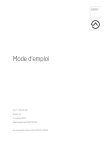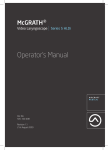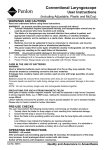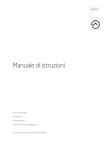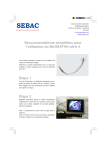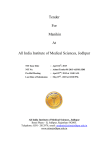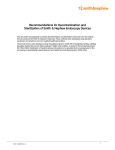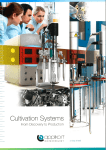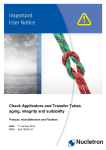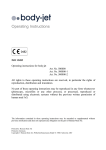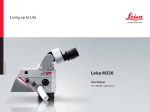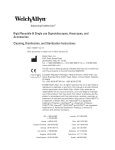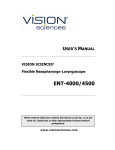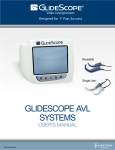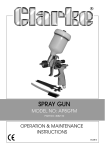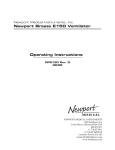Download "user manual"
Transcript
Contents 1 Introduction 2 1.1 Description 2 1.2 Accessories and Part Numbers 2 1.3 Specifications 3 1.4 Regulatory 3 2 Functional 4 2.1 Unpacking and Inspection 4 2.2 Battery 4 2.3 Screen information 5 2.4 Blade Fitting 6 2.5 Using the Laryngoscope 7 3 Maintenance and Decontamination 11 3.1 Decontamination 11 3.2 Warnings 12 3.3 Cleaning 12 3.4 Disinfection 12 3.5 Sterilization 12 3.6 Drying, Storage and Transportation 13 3.7 Troubleshooting, Replacement Parts and Repair 13 4 Warranty 15 1 Introduction 1.1 Description The McGRATH® MAC Video Laryngoscope (the device) is a tool used to aid the intubation of the trachea. As a rigid laryngoscope it holds and shapes the anatomy allowing a clear view of the larynx and entrance to the trachea. The need to provide a secure airway is fundamental to an anesthesiologist’s role prior to a surgical procedure. Paramedics, emergency physicians and General Practitioners may also be required to insert a tracheal tube in an emergency to keep the airway open where an unconscious patient is undergoing cardio-pulmonary resuscitation. The device incorporates a light source and miniature camera to view the larynx during the procedure of intubation. The image is displayed on an LCD screen mounted to the handle of the device. A single proprietary battery pack mounted within the handle powers the camera, display and light. The battery is supplied high level disinfected. The McGRATH® MAC blade covers the camera and light assembly (CameraStick™) to prevent direct patient contact. The McGRATH® MAC blade is supplied sterile. 1.2 Accessories and Part Numbers UNDER NO CIRCUMSTANCES SHOULD ANY OTHER TYPE OF LARYNGOSCOPE BLADE BE USED WITH THIS MEDICAL DEVICE DO NOT OPEN ANY SEALED PART OF THE DEVICE UNDER ANY CIRCUMSTANCES. TO DO SO WILL IMPAIR THE PERFORMANCE OF THE DEVICE AND PATIENT SAFETY The device is supplied with a battery. Blades and additional batteries should be purchased separately from your local seller. McGRATH® MAC Video Laryngoscope 300-000-000 Battery Disposable Power Unit 340-000-000 MAC 3 Intubation Blades (Carton of 50) 350-005-000 MAC 4 Intubation Blades (Carton of 50) 350-013-000 1.3 Specifications Laryngoscope Assembly Size 180mm x 68mm x 110mm Weight 0.200kg Power Proprietary 3.6V Lithium Battery Pack *Giving 400 minutes of use typically Light source High intensity LED Display 2.5” LCD colour display Camera CMOS Protection IPx7 Materials Durable medical grade thermoplastics with reinforced structural alloy core. The device and packaging are latex free *IN CONDITIONS WHERE THE AMBIENT TEMPERATURE DROPS BELOW 20°C THE TIME MAY REDUCE Disposable Intubation Blade The device can be used only with McGRATH® MAC disposable intubation blades Material Medical grade optical polymer. Packaging Packaged sterile for single use only This device and packaging are latex free. 1.4 Regulatory This product complies with EN 60601-1 and EN 60601-1-2 safety standards. The CE mark indicates that it meets the requirements of European Council Directive 93/42/EEC concerning medical devices. The device is regulated in the USA under FDA Regulation Number 868.5540 and device listed under the name McGRATH MAC. “McGRATH” is a registered trademark of Aircraft Medical Limited. “Aircraft” is a registered trademark of Aircraft Medical Limited. “CameraStick” is a trademark of Aircraft Medical Limited. Only personnel trained in and licensed to perform intubation with a laryngoscope may use this device. The user must contact an Aircraft Medical approved agent or distributor to arrange responsible disposal and compliance with Waste Electrical and Electronic Equipment regulations applicable, and any similar future environmental regulation applicable (including but not limited to Directives 2002/95/EC and 2002/96/EC as implemented in the Territory). CAUTION : FEDERAL (USA) LAW RESTRICTS THIS DEVICE TO SALE BY OR ON THE ORDER OF A LICENSED PRACTITIONER 2 Functional 2.1 Unpacking and Inspection Unpack the device and check for any visible signs of damage that may have occurred during shipment. In the event of signs of damage do not use the laryngoscope and inform the local agent or distributor. Both the device and battery are supplied in a non-sterile state. It will be necessary to disinfect the laryngoscope before use on a patient (please refer to section 3.3 Cleaning). The laryngoscope blade is supplied in a sterile state. Ensure that handling precautions are taken in accordance with local, national and harmonised standards. 2.2 Battery The device will only accept the proprietary battery. Push the battery into the cavity of the device handle as illustrated. The device turns on and off by a single push of the Power button. Power button (Stand-by) Tab The life of the battery is displayed on the bottom right hand corner of the screen. This counts down from 400 as each unit of power is consumed. When the counter reaches 5, the battery icon will flash. Replace the battery when this happens. Remove the battery by pulling the tab and dispose of under local regulations for disposal of batteries. If the device is not to be used for an extended period of time (more than 1 month) remove the battery before storage. Flashing *IN CONDITIONS WHERE THE AMBIENT TEMPERATURE DROPS BELOW 20°C THE LIFE OF THE BATTERY MAY BE REDUCED 2.3 Blade Fitting The device is designed to be used only with McGRATH® MAC disposable intubation blades. The McGRATH® MAC blades are single use, supplied sterile and MUST be disposed of after each patient use. To fit the blade, remove the blade from packaging and slide over the CameraStick™ portion of the device. The blade is fully located when the blade clip is firmly latched to the CameraStick™. To remove the blade lift the clip and pull the blade off. ENSURE THAT LOCAL HANDLING PROCEDURES ARE FOLLOWED AT ALL TIMES WHILE HANDLING DISINFECTED DEVICES CHECK THAT THE BLADE IS CORRECTLY FITTED TO THE CAMERASTICK™ BEFORE USING ON A PATIENT. McGRATH® MAC BLADES MUST ONLY BE USED WITH A McGRATH® MAC VIDEO LARYNGOSCOPE DO NOT ATTEMPT TO USE ANY OTHER LARYNGOSCOPE BLADE WITH THE DEVICE IF THERE IS ANY EVIDENCE THAT THE BLADE PACKAGING HAS BEEN BREACHED, DO NOT USE THE BLADE DO NOT APPLY DEFOGGING LIQUID ON THE CAMERASTICK™ OR ON INTERNAL SURFACES OF THE BLADE. IF DEFOGGING LIQUID IS USED THIS SHOULD BE APPLIED TO THE EXTERNAL SURFACE OF THE BLADE 2.4 Using the Laryngoscope If possible, position the patient in the optimal position for direct laryngoscopy. Look into the mouth; insert the blade into the right side of the mouth, moving the device to a central position while sweeping the tongue to the left. Alternatively a midline approach can be adopted. Advance the blade into the vallecula. Visualize the epiglottis on the screen. Lift the anatomy forwards and upwards to expose a direct and indirect view of the glottis. When the device is in the optimal position the glottis should be viewed in the central upper section of the screen. Alternatively a gentle pivoting motion can be used to lift the epiglottis to provide an indirect view. Advance the tube gently and atraumatically through the vocal cords. Tube placement can be performed either by looking directly in the mouth, indirectly on the screen or a combination of both. If a direct pathway for the tube was not created by sweeping the tongue or aligning the airway axes a stylet or a bougie may need to be used. Indirectly visualize the tube placement through the vocal cords The screen view can be used to confirm the correct insertion depth of the endotracheal tube. 3 Maintenance and Decontamination 3.1 Decontamination These methods of decontamination were developed using standard equipment and practices common to global healthcare facilities and according to regulatory requirements using the guidance given in AAMI TIR 12 (Designing, Testing, Labelling Reusable Medical Devices for Reprocessing in Health Care Facilities: A Guide for Device Manufacturers) and ISO 17664:2004 (Sterilization of medical devices Information to be provided by the manufacturer for the processing of resterilizable medical devices). The device should be decontaminated after each patient use. Disinfection or sterilization should be carried out in accordance with local guidelines. Thorough cleaning and rinsing are vital for the decontamination of the product. The purpose of cleaning and rinsing is to remove all visible soil and to reduce the number of particulates, microorganisms, and pyrogens. Thorough rinsing is important for removing any residual cleaning agents from the medical device. The following decontamination methods have been validated by Aircraft Medical together with external, independent experts and companies. Manual Cleaning & Disinfection Automatic Chemical Washer Disinfector (Endoscope Reprocessor) Ethylene Oxide Sterilisation Other decontamination methods may be suitable but must be validated by the user of the device before use. 3.2 Warnings ENSURE THE DEVICE IS COMPLETELY DRY BEFORE USING DO NOT AUTOCLAVE THIS DEVICE DO NOT USE THIS DEVICE IN AN ULTRASONIC CLEANER Ensure that personnel carrying out the decontamination are dressed appropriately with suitable personal protective equipment (PPE). PPE and clothing should be used in accordance with local regulations and should be checked by a competent supervisor. Ensure that appropriate assessments for hazardous materials are carried out prior to using, storing or transporting any hazardous substances. Dispose of all chemicals used in accordance with manufacturer’s guidelines. 3.3 Cleaning For cleaning follow the steps below: 1. Ensure the disposable blade has been removed and disposed of. 2. The display is in the upright (parallel with handle) position 3. Remove the battery and process separately The device does not require any further disassembly THE BATTERY MUST BE REPROCESSED INDIVIDUALLY Compatible Methods of Cleaning The device is compatible with both manual and automated methods of cleaning. Automated Cleaning (McGRATH® MAC) The device is compatible with an automated washer system operating the following cycle: A pre-wash rinse where the product is sprayed with cold clean water Dosing of Enzymatic or Alkaline Detergent Washing phase, during which the temperature of the water with detergent and chamber must be sustained between 50°C - 70°C for 3 minutes The products are thoroughly rinsed for 2.5 minutes with reverse osmosis water Automated wash cycles should be validated to be compatible with the device and at least as effective at removing soiling as the manual cleaning procedure detailed below. The effectiveness of the automated cleaning cycle is reliant upon the configuration of the load within the machine. Devices should be arranged in such a way to ensure that they are all effectively cleaned in accordance with the washer disinfector manufacturer’s guidelines. This device must not be placed in any kind of ultrasonic cleaner. Manual Cleaning (McGRATH® MAC) Equipment required for manual cleaning: A warm water/detergent solution at correct dilution such as ENDOZYME® or ENZOL® A clean, disposable, absorbent, non-shedding cloth for application of detergent solution A clean, disposable, absorbent, non-shedding cloth for wiping product. (Aircraft Medical recommend the use of an ultra-absorbent microfiber cloth.) Manual Cleaning Instructions Pre-clean by immersing the device for a minimum of 5 minutes in enzymatic detergent. Use cleaning brushes to remove soiling, taking care not to scratch optical surfaces. Scrub crevices and around hinged surfaces with a brush. Rinse thoroughly with warm water. Check instruments for visible soil. Repeat cleaning if soil is visible. Immerse the cleaning cloth in the enzymatic detergent solution and wring thoroughly. Wipe all surfaces thoroughly ensuring that detergent solution comes into contact with all surfaces. Periodically rinse the cloth in clean water and repeat the above steps. Surfaces should be carefully hand-dried using a cloth or industrial hot air dryer ( no greater than 70°C ) or placed into a drying cabinet. Safely dispose of cleaning materials. Other compatible chemical solutions have been approved by Aircraft Medical Ltd which cause no physical degradation to the McGRATH® MAC Video Laryngoscope. However, tests show that long term exposure to some chemicals may cause a minor discolouration due to bleaching effects. Please contact Aircraft Medical for more information on these agents. Aircraft Medical make no comment regarding their decontaminating effectiveness. 3.4 Disinfection General Guidelines for Disinfection Ensure that the device has been cleaned, rinsed and dried prior to disinfection. All irritant disinfectant residues should be removed before the item is reused and care should be taken when rinsing to ensure that items are not re-contaminated during this procedure. Receptacles and containers used to contain devices should be cleaned before use. Compatible Methods of Disinfection Automated Chemical Disinfection (McGRATH® MAC) The device is compatible with an automated chemical washer disinfector operating the following cycle: (normally following immediately from an automated cleaning cycle): Following the cleaning and rinsing cycle, the machine immediately commences the disinfection process where the product is sprayed with Peracetic Acid-based chemical disinfectant. The product is then rinsed with reverse osmosis water continuously to remove any traces of chemical disinfectant. The drying cycle should commence immediately upon completion of the disinfection phase. Manual Disinfection (McGRATH® MAC) Equipment required for Manual Disinfection A receptacle (with a lid) which can be disinfected and with sufficient capacity to immerse the item fully A means to contain or extract any irritant vapours A solution of freshly prepared chemical disinfectant, at the recommended manufacturer’s concentration such as Cidex OPA A receptacle which can be sterilized or disinfected to contain rinse water Sterile clean water to rinse items after chemical disinfection A clean, disposable, absorbent, non-shedding cloth or mechanical drying facility. (Aircraft recommend the use of an ultra-absorbent microfiber cloth.) Manual Disinfection Instructions Liquid chemical disinfectants can be supplied ready to use or may require mixing with an activator. Alternatively it may need accurate dilution to its in-use strength as per the manufacturer’s instructions. Ensure that the disinfectant receptacle is clean and dry. Wearing appropriate personal protective equipment, to include impervious gown, Nitrile or Butyl gloves, face mask/shield or face shield, fill the receptacle with sufficient prepared disinfectant solution so as to ensure complete immersion of the item to be processed. Carefully immerse the item in the solution in such a way as to displace any trapped air within the item; it is important to ensure that the solution reaches all surfaces. Place the lid on the receptacle and leave for the recommended time. Follow manufacturers’ recommended soak times: Cidex OPA - 12 minutes @ 25°C Metricide OPA – 12 minutes @25°C Cidex Plus – 20 minutes @ 25°C Metricide – 45 minutes @ 25°C Cidex – 45 minutes @ 25°C Metricide 28 – 90 minutes @ 25°C Remove the device from the solution, drain into receptacle before transferring to clean rinse receptacle. Rinse thoroughly with sterile water of suitable microbiological quality. Remove the device from the rinse solution and drain. Carefully hand-dry the device using clean, absorbent, non-shedding cloth or industrial hot air dryer or place into drying cabinet. 3.5 Sterilization Preparation for Sterilization Ensure that the device has been cleaned, rinsed and dried in accordance with section 3.2 prior to disinfection. The battery should be removed prior to EtO or Sterrad sterilization cycles. The battery module may be cleaned prior to sterilization by the use of IPA wipes. Compatible Methods of Sterilzation (McGRATH® MAC & Battery) Ethylene Oxide Sterilization The device is compatible with EtO sterilizing processes. Atomised Hydrogen Peroxide Sterilization Sterilize as instructed in the STERRAD User Manual (the standard cycle contains no user variables). The device is compatible with the following cycles: STERRAD 100® STERRAD 200® STERRAD NX® 3.6 Drying, Storage and Transportation Drying The device should be dried immediately upon completion of any post-disinfection rinse. Carefully hand-dry using clean, absorbent, non-shedding cloth or industrial hot air dryer or place into drying cabinet. Storage & Transportation Used devices should be cleaned immediately after use and prior to storage to limit the adhesion of any soiling. Clean devices should be packaged immediately upon completion of the drying phase and should be stored in accordance with local guidelines. Ensure that the devices are placed in suitable containers in accordance with local hospital practice. Containers used to transport devices should be durable and suitable for decontamination. 3.7 Troubleshooting, Replacement Parts and Repair When switched on, there is no display on the screen. Replace battery Poor picture quality The image displayed on the screen is blurred or fuzzy Check for fogging on the intubation blade. Remove the blade and check that the image is clear and bright. If necessary wipe the camera at the end of the CameraStick™ with a clean, soft wipe. If none of the above achieves positive results, return the unit to your local seller for diagnostics and repair. Loose or poorly fitting components If any components become loose, physically damaged or fit poorly, under no circumstances use the equipment and return to your local seller for repair or replacement. 4 Warranty Aircraft Medical Limited warrants that the device supplied is, on leaving the factory, free from defects in materials or workmanship. This warranty is valid only if the product is supplied to the end user by an Aircraft approved agent or distributor and has been maintained in accordance with procedures documented in the Operator’s Manual. If failure occurs from manufacturing defects within 12 months of purchase, Aircraft Medical will repair or replace the defective item.
















